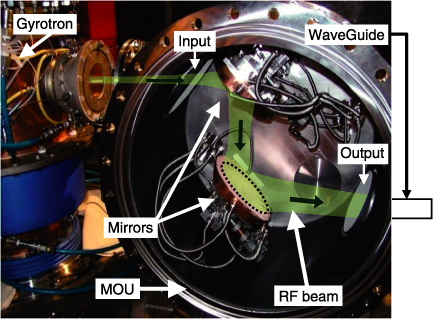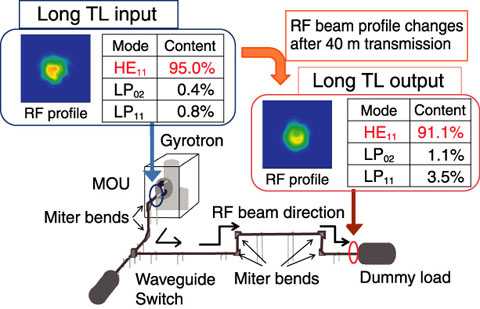
Fig.3-8 Modified MOU

Fig.3-9 Configuration of high-power TL and RF beam profile and mode content at the TL input and output
The electron cyclotron heating and current drive (EC H & CD), which is a tool for heating and sustaining the plasma by a high-power millimeter wave, is a major heating system in the ITER. In the ITER, 1 MW/170 GHz RF power generated by the gyrotron is transmitted to the fusion plasma by a transmission line (TL) that is more than 100 m long. To a chieve high transmission efficiency in the long-distance TL that includes a corrugated waveguide system (diameter: 63.5 mm), high purity of the fundamental transmission mode (HE11 mode) should be realized so that transmission loss is minimized.
For this purpose, we fabricated an ITER-relevant high-power, long-distance TL test system, performed an experiment for improving the HE11 mode purity, and demonstrated high-efficiency high-power RF transmission. First, we modified the matching optics unit (MOU) to improve the HE11 mode purity. The MOU includes two mirrors that transfer the RF power from the gyrotron to the corrugated waveguide, as shown in Fig.3-8. Using the modified mirror adjustment mechanism, we optimized the mirror angles and achieved an HE11 mode purity of 95%. Next, we estimated the influence of long-distance power transmission on the mode purity by using the transmission system shown in Fig.3-9. A high HE11 mode content of 91% was maintained at the end of the 40 m long TL when the mode purity was 95%. The total power in the unwanted higher-order modes (LP02, LP11) that were generated was 4%, which was acceptable for the ITER.
Finally, the transmission efficiency was measured. The transmitted power was measured by the dummy load installed at the end of the TL. The transmission loss was also identified by measuring the heat deposition in the intermediate components. From the results, the transmission efficiency was confirmed to be 96%, which well exceeded the ITER requirement.